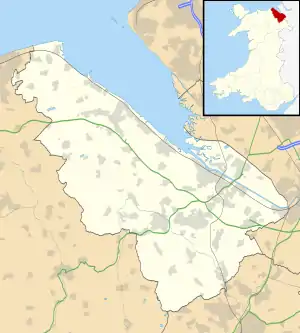Flint Town Hall
Flint Town Hall (Welsh: Neuadd y Dref Y Fflint) is a municipal structure in the Market Square, Flint, Flintshire, Wales. The town hall, which is the meeting place of Flint Town Council, is a Grade II listed building.[1]
| Flint Town Hall | |
|---|---|
| Native name Neuadd y Dref Y Fflint | |
.jpg.webp) Flint Town Hall | |
| Location | Market Square, Flint |
| Coordinates | 53.2500°N 3.1337°W |
| Built | 1840 |
| Architect | John Welch |
| Architectural style(s) | Gothic Revival style |
Listed Building – Grade II | |
| Official name | Town Hall |
| Designated | 5 December 1972 |
| Reference no. | 14891 |
 Shown in Flintshire | |
History
.jpg.webp)
The first municipal building in Flint was a half timbered town hall which was completed in the early 16th century.[2] After the old building became dilapidated, civic leaders decided to demolish it and to erect a new town hall, financed by public subscription, in its place.[2]
The new building was designed by John Welch in the Gothic Revival style, built in ashlar stone at a cost of £1,734 and was completed in February 1840.[3] The design involved a symmetrical main frontage with three bays facing onto the Market Square; the central bay, which was projected forward, originally featured an arched doorway on the ground floor; there was a Venetian window with a balcony and a wrought-iron balustrade on the first floor, and an archway, a stepped gable and a stone finial above.[1] The central bay was flanked by full-height castellated turrets.[1] The outer bays were represented by the side elevations of two lean-to wings.[1] Internally, the principal rooms were the council chamber, which featured a hammerbeam roof made from timbers recovered from the first town hall, and the mayor's parlour.[1] The mayor's parlour was decorated at the expense of one of the burgesses, Ross Mahon, by fifteen panels, painted by Joseph Hall and depicting the Fifteen Tribes of Wales.[1]
After significant population growth, largely associated with Flint's status as a market town, the area became a municipal borough, with the town hall as its headquarters, in 1835.[4] The building also continued to be used for judicial purposes: both the county court and petty session hearings were held there.[2] Six stained glass windows, designed by a Mr Drewitt depicting the six monarchs who had granted the town its charters, were installed in the council chamber in 1886.[2] Representatives of the 384th (Royal Welch Fusiliers) Anti-Tank Regiment, Royal Artillery attended the town hall to receive the freedom of the borough in August 1947.[3]
The building continued to serve as the headquarters of the Flint Borough Council for much of the rest of the 20th century,[5] but ceased to be the local seat of government after the enlarged Delyn District Council was formed at the civic offices in Holywell in 1974.[6] The town hall subsequently became the meeting place of Flint Town Council.[7] An extensive programme of refurbishment words, which included restoration of the façade of the building, to a design by Donald Insall Associates, was completed in 2015.[8]
Works of art in the town hall include portraits by Thomas Leonard Hughes of King Richard II,[9][lower-alpha 1] and of Sir Roger Mostyn, 1st Baronet.[10] Richard II surrendered to Henry Bolingbroke at Flint Castle in August 1399, promising to abdicate the throne if his life was spared,[11] while Mostyn defended Flint Castle on behalf of the Royalists against the besieging Parliamentary forces in August 1646 during the English Civil War.[12] There is also a painting by Hector Giacomelli of a scene from William Shakespeare's play The Merchant of Venice.[13]
Notes
- The portrait of Richard II is based on a similar depiction of the king in Westminster Abbey.[3]
References
- Cadw. "Town Hall (14891)". National Historic Assets of Wales. Retrieved 20 August 2021.
- "Flint". Slater's Directory of North and Mid Wales. 1895. Retrieved 20 August 2021.
- "The Town Hall". Flint Through The Ages. Retrieved 20 August 2021.
- "Flint MB". Vision of Britain. Retrieved 20 August 2021.
- "No. 46055". The London Gazette. 20 August 1973. p. 10027.
- Local Government Act 1972. 1972 c.70. The Stationery Office Ltd. 1997. ISBN 0-10-547072-4.
- "All Councillors". Flint Town Council. Retrieved 20 August 2021.
- "Flint Town Hall". Donald Insall Associates. Retrieved 20 August 2021.
- Hughes, Thomas Leonard. "Richard II (1367–1400)". Art UK. Retrieved 20 August 2021.
- Hughes, Thomas Leonard. "Colonel Sir Roger Mostyn, the Gallant Defender of Flint Castle (1643)". Art UK. Retrieved 20 August 2021.
- "Richard II, King of England (1367–1400)". Luminarium.org. Retrieved 20 August 2021.
- "Flint Castle". Castles Forts Battles. Retrieved 20 August 2021.
- Giacomelli, Hector. "'The Merchant of Venice', Act II, Scene 8". Art UK. Retrieved 20 August 2021.